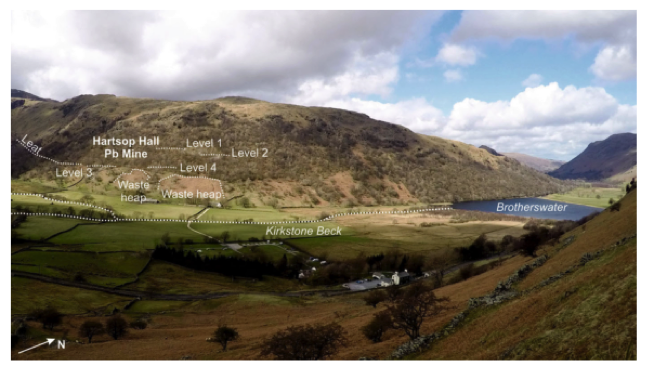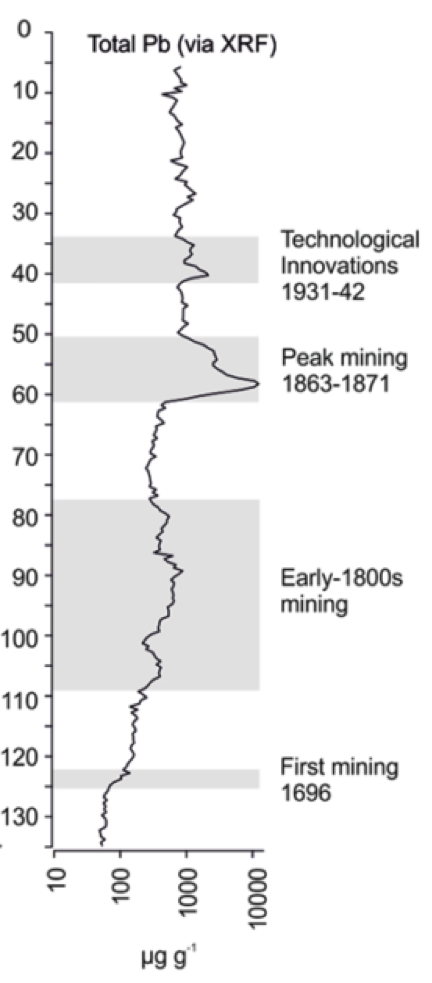This post was written by King’s Water Member and Teaching Fellow Dr Daniel Schillereff to reflect on a recent paper, “Quantifying system disturbance and recovery from historical mining-derived metal contamination at Brotherswater, northwest England”. The journal article was made Open Access through the agreement between King’s College London and Springer and thus is freely available online.
If you’ve ever been on a hike in the Lake District, the Pennines, or Cornwall, you’ve probably walked past evidence of historical mining. Ruined infrastructure, spoil heaps spread across hillslopes, and some adits and levels can be explored today. Britain has a long mining legacy, with firm evidence of widespread mineral extraction during the Roman era and a few even older sites. But along with cool history and climbing, the potential impacts on aquatic ecosystems of metals released during mining and smelting can also be seen. Harmful effects have been amplified by the fact that early processing techniques could extract only a limited percentage of the metal ore, leaving much behind to enter into waterways.
This form of mining waste falls under the EU Water Framework Directive (WFD), which has led to a growing national impetus to assess and address the extent of aquatic pollution from mining. However, the Water Framework Directive requires reference conditions to be set (i.e., what is the natural level of trace metals in a system, without or pre-human intervention) and contemporary assessments do not offer a long-term perspective. Whether contamination during peak mining (generally the late-19th century) was more acute is also uncertain, given limited data. Nor can much be said about the trajectory towards recovery since mining ceased, which occurred in the 1930s and 40s at most mines. Our recent study set out to use sediment cores and mining records to begin exploring these issues.

The sediments that accumulate at the bottom of a lake can record environmental changes through time if a sediment characteristic is altered in some way. While analysing the sediments of a small lake in the Lake District (Figure 1) for another research project, co-workers and I noted exceptionally high levels of lead (Pb) in Brotherswater. Further investigation highlighted a tight match between the pattern of Pb accumulation through time in the basal sediments and the written history of ore extraction at Hartsop Hall Mine, about half a kilometre upstream of the lake.


We recently published a paper in the Journal of Paleolimnology that reconstructed the amount of lead, zinc and copper that has accumulated in the sediments of Brotherswater. The first documented evidence of mining at Hartsop Hall was in 1696. This first and subsequent mining phases occurred in short intervals owing to inclement weather and inadequate financing, reflected by peaks in the Pb profile. According to company records, ore extraction peaked in the 1860s and early 1870s – at which time lead concentrations in the lake exceeded 10,000 parts per million (ppm) (Figure 4). As a reference, international guidelines stipulate Pb concentrations higher than 47 ppm can be deemed harmful, with potentially severe effects seen above 236 ppm. It’s also worth noting that this is a different source than the many lakes across Europe, North America and the world that have received trace metals as atmospheric pollution, especially from car emissions and coal combustion. The Pb signatures in these lakes and peatlands tends to peak at ‘only’ a few hundred ppm in the mid-20th century, before leaded petrol was phased out. Our estimates suggest over 15,000 kg of lead is stored in the sediments of Brotherswater; almost worth mining the lake itself! (Tongue firmly in cheek, although it highlights the exceptional concentrations.)

From a purely scientific perspective, the accumulation of trace metals during mining offers some valuable chronological markers. All attempts to infer environmental or climatic histories from a natural archive, such as a lake sediment record, must be underpinned by some knowledge of timescale. For lake sediments, the measurement of different radionuclides is the most common approach, where we know the half-life of a particular isotope. 20th century sediments can usually be well-dated using 210Pb and artificial radionuclides associated with nuclear weapons testing and the Chernobyl disaster. Over longer timescales, radiocarbon (14C) dating is the conventional tool, but the intervening period (the 18th and 19th centuries) presents recurring challenges. This is conveniently the period through which multiple mining markers can be distinguished from the lead profile in the sediments. We are fairly confident of these timings and embed these dates into our master chronology. Other on-going work reveals equivalent records in other Cumbrian lakes, and this approach has been used all over the world.
The last thing we set out to do was examine the system’s recovery trajectory. Hartsop Hall Mine closed permanently in 1942, but the upper sediment layers in the recovered cores along with material we captured in sediment traps installed in Brotherswater since 2012 show that high lead concentrations remain. While concentrations have declined since the mine’s closure, they remain far higher than pre-mining (~800 ppm compared to ~60 ppm). Various geomorphic processes may alter the trajectory (for example, floods mobilise contaminated sediment stored in the floodplain), but the current linear rate of decline suggests it could take another 150 years for concentrations in the lake to return to their reference, ‘natural’ baseline.

On the one hand, the fact that this could occur without human intervention could be put forward as a positive. But it is worth keeping in mind the small scale of operations at Brotherswater. Greenside Mine (Figure 5), which drains into Ullswater a few kilometres north, was one of the largest mines in the Lake District. Today, there are many other vast abandoned mining complexes across the country. Efforts are now underway to reduce diffuse pollution from some abandoned mines but many sites, especially smaller ones such as Hartsop Hall, are not on the radar given the assumption of limited risk. Our work shows this is sadly not the case. Mining waste is thus one of a number of grave problems faced by the UK if it is to meet WFD guidelines in the agreed timeframe.